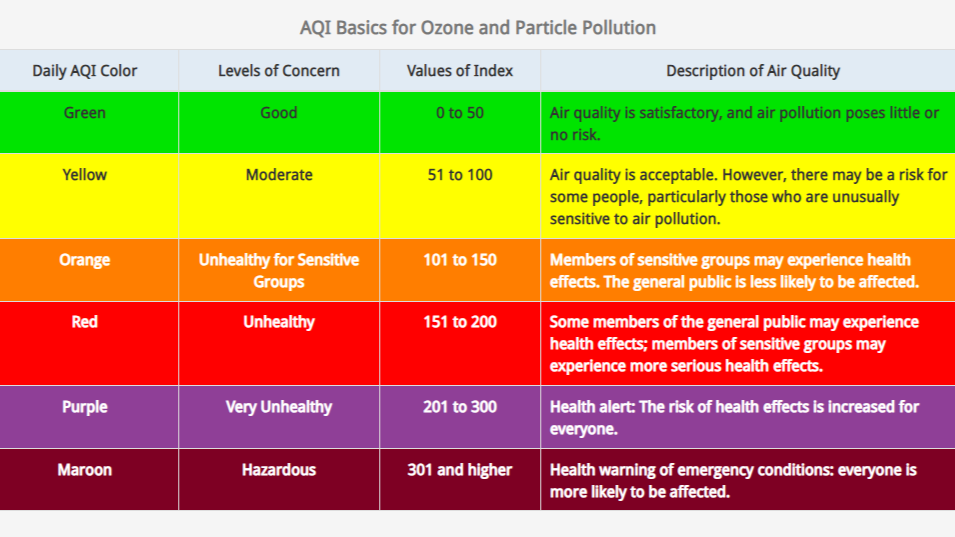
What can we do about the unhealthy air quality in Chicago?
Understanding what AQI numbers mean, keeping yourself safe when there is unhealthy air and taking action on climate.

Headlines at the end of June 2023 in Chicago read “Chicago Has Some Of The Worst Air Quality In Major Cities Right Now. Here’s How To Protect Yourself” and “Chicago’s air quality: ‘We’re in the crosshairs.’ Wildfires and wind push region’s air to worst in the world, global pollution index shows.” If you’re like us you’ve likely have had many conversations over the last few days about the smoky smell in the air, how to keep yourself safe during your commute, and what the future looks like with more wildfires and wildfire smoke.
With the potential for more smoky days ahead whether from wildfires this summer or future wildfire seasons, it’s a good time to familiarize yourself with tools for understanding air quality, how to keep yourself and your family safe and ways to take action on climate.
What does AQI mean?
The Air Quality Index (AQI) is a measurement created by the Environmental Protection Agency (EPA) to tell us how healthy our air is to breathe. It’s a calculation based on the presence of 5 pollutants: ground level ozone, carbon monoxide, sulfur dioxide, nitrogen dioxide, and particle pollution. Exposure to any of these pollutants can cause serious health effects for everyone. With wildfire smoke, one of the most concerning types of pollutants is particle pollution, especially particles that are very small, referred to as PM 2.5. This type of particle pollution can cause devastating health effects for the lungs and heart.
Depending on where you’re getting your air quality information, you may hear the AQIdescribed as either a number or a color. Think of this chart like a stop light: if it’s green, you can go outside. If it’s yellow or orange, think twice – especially if you’re part of a “sensitive group”. If it’s red, stay inside. If it’s purple or maroon, take extra precautions to protect yourself.
Many weather apps, the local news and various online sources have information about the air quality in your area.

What you should do when your area has unhealthy air
Smoke is a serious situation and should not be taken lightly. Listening to trusted public health authorities in your area. Their expertise is crucial to understanding what the situation is in your specific location.
Orange – When the air quality is orange, everyone should consider their plans for the day. Sensitive groups should avoid outdoor exposure, and everyone should avoid extended periods of strenuous activity in the outdoors.
Red – Stay inside when you can; every hour of time spent outside adds to the health risk. Sensitive groups should be extra careful to limit time spent outside. Instead, find ways to exercise and entertain yourself indoors.

Climate change is likely to make our air even unhealthier
Global warming is likely to make air pollution worse in the years to come by increasing the frequency and severity of wildfires. Global warming has already caused wildfires in western states to burn more land, burn for longer and burn during more of the year than they did a few decades ago. And that wildfire smoke is a major source of particulate pollution. Higher temperatures, which global warming will make more frequent, can also increase ozone levels, one of the pollutants that influences the AQI. Global warming could also decrease air circulation, trapping pollution near the ground where it is most unhealthy.
Take action on climate today
To avoid the most catastrophic effects of climate change, it is clear we need to take action. In the United States the #1 source of global warming pollution is transportation. The good news is that we have never been closer to an electric vehicle future than we are right now — a future where our kids ride electric buses to school, our mail and packages arrive in electric trucks, and every new car that is sold gets plugged in at night. Together, we can protect our climate by accelerating the transition to an electric vehicle future.

Electric Vehicles Save Money for Government Fleets
Topics
Authors
Emily Kowalski
Outreach & Engagement Manager, Environment Illinois Research & Education Center
Emily manages the marketing and public engagement strategy for Environment Illinois's campaigns, including our campaign to protect the Great Lakes from plastic pollution. Emily lives in Chicago where she enjoys knitting and biking.
Abe Scarr
State Director, Illinois PIRG Education Fund
Abe Scarr is the director of Illinois PIRG and is the PIRG Energy and Utilities Program Director. He is a lead advocate in the Illinois Capitol and in the media for stronger consumer protections, utility accountability, and good government. In 2017, Abe led a coalition to pass legislation to implement automatic voter registration in Illinois, winning unanimous support in the Illinois General Assembly for the bill. He has co-authored multiple in-depth reports on Illinois utility policy and leads coalition campaigns to reform the Peoples Gas pipe replacement program. As PIRG's Energy and Utilities Program Director, Abe supports PIRG energy and utility campaigns across the country and leads the national Gas Stoves coalition. He also serves as a board member for the Consumer Federation of America. Abe lives in Chicago, where he enjoys biking, cooking and tending his garden.
Find Out More

Methane emissions are accelerating climate change — here’s what we can do about it

Cleaner air in Steel City

A look back at what our unique network accomplished in 2023


